Consumer Price Index in the NCR remains at 121.9 percent
The Consumer Price Index (CPI) for the National Capital Region (NCR) remained at 121.9 percent from February to March 2024. In comparison to March 2023, the CPI displayed a year-on-year rise of 3.9 percentage points, ascending from 118.0 percent. Throughout this timeframe, the NCR's CPI consistently stayed below the overall CPI of the Philippines, which reached 125.6 percent in March 2024, marking a 0.1 percentage point increase from the previous month's index of 125.5 percent.
In March 2024, the CPI of 121.9 percent indicates that consumer prices in the NCR has risen by 21.9 percent compared to the base year of 2018. This means that a basket of goods valued at PHP 100.00 in 2018 can now be purchased at PHP 121.9 in March 2024 by an average Filipino household in NCR. (Figure 1)
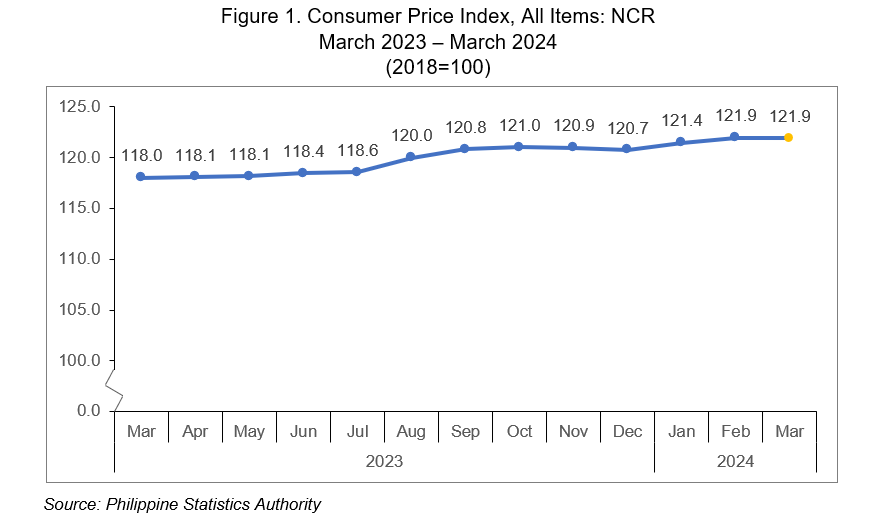
Inflation rate in NCR slightly upticks to 3.3 percent.
In March 2024, the inflation rate in NCR experienced a marginal uptick reaching 3.3 percent, compared to 3.2 percent in February 2024. This marks a 0.1 percentage point increase in inflation compared to the preceding month. In March 2023, the inflation rate in the region stood at 7.8 percent. (Figure 2)
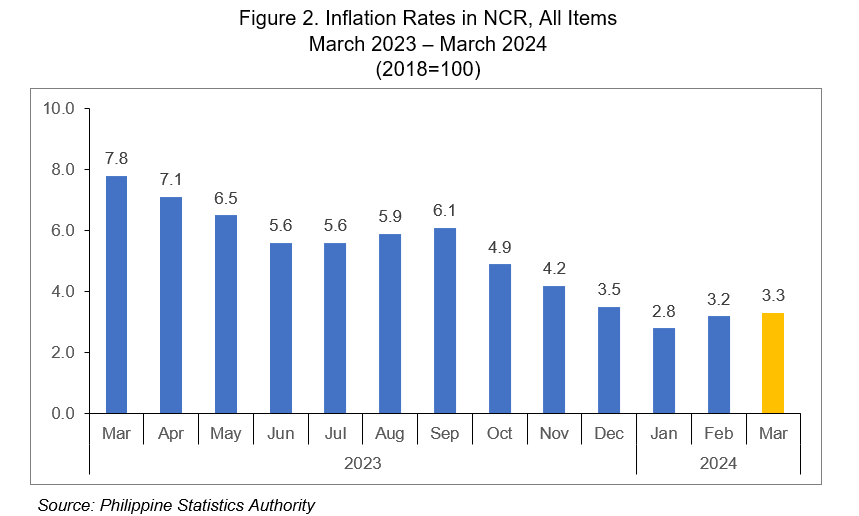
Similarly, on a national scale, inflation in the Philippines saw a slight increase to 3.7 percent in March 2024 from 3.4 percent in February 2024. This upward trajectory in inflation was observed across fourteen (14) out of the seventeen regions. Region IX (Zamboanga Peninsula) observed the most significant increase in its inflation rate, with a rise of 1.3 percentage points. This was followed by Region II (Cagayan Valley) and CAR, each experiencing an increase of 1.0 and 0.9 percentage points, respectively.
Food and non-alcoholic beverages still contributes to the acceleration of inflation within the NCR.
The food and non-alcoholic beverages index remained the most significant contributor to the increase in the inflation rate in NCR with a 1.2 percentage points increase from its 3.3 percent inflation rate in February 2024 to reach 4.5 percent this March 2024. The increase in the inflation rate in food and non-alcoholic beverages contributed to around 80.5 percent to the overall uptrend in inflation for the month. The index of transport commodity group came next as the major contributor to higher inflation in the region as it accelerates to 2.2 percent this March 2024 from 1.3 percent inflation rate in February 2024 and it was followed by the index of clothing and footwear which registered an increase of 0.2 percentage point from its 2.0 percent inflation in February 2024 to reach 2.2 percent in March 2024. In addition, the indexes of information and communication, furnishings, household equipment and routine household maintenance, and financial services saw a slight uptick of 0.1 percentage points to their inflation rates this March 2024 as compared to February.
On the other hand, annual decrease were observed in the indices of the following commodity groups:
Alcoholic beverages and tobacco, 5.2 percent;
Housing, water, electricity, gas, and other fuels, 2.4 percent;
Recreation, sport and culture, 0.0 percent;
Education services, 0.0 percent;
Restaurant and accommodation services, 0.0 percent; and
Personal care, and miscellaneous goods and services, 0.0 percent.
Meanwhile, the annual growth rate for the remaining commodity group of health held on to the previous month’s record. (Table 1)
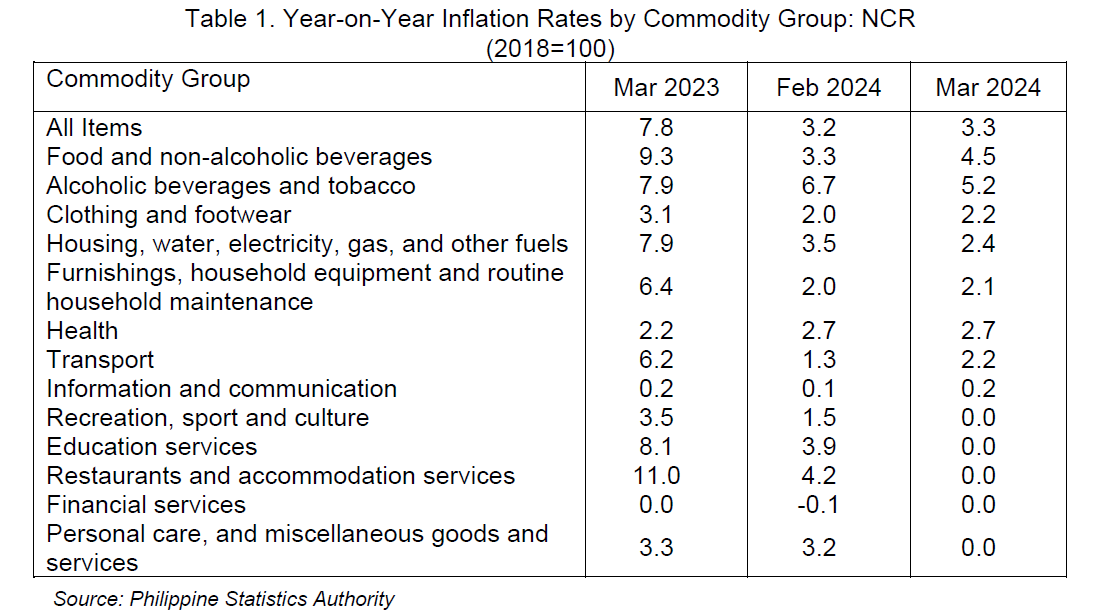
Food inflation rises to 4.7 percent
Inflation of food rises to 4.7 percent this March 2024, recording a 1.2 percentage points increase from its 3.5 percent inflation in February 2024. The speed up of food inflation was mainly brought by the higher year-on-year growth rate in the index of vegetables, tubers, plantains, cooking bananas and pulses which increased to 4.3 percent in March 2024 from negative 8.3 percent in February 2024. This was followed by the index of meat and other parts of slaughtered land animals which registered an annual increase of 2.1 percent this month from 0.5 percent in February 2024, and the commodity groups of rice and corn which registered higher inflation with upticks of 0.4 and 0.9 percentage points on their inflation rate, respectively.
Meanwhile, the following seven commodity groups exhibited lower inflation this month:
Flour, bread and other bakery products, pasta products, and other cereals,
4.1 percent;Fish and other seafood, 1.4 percent;
Milk, other dairy products and eggs, 0.8 percent;
Oils and fats, -5.9 percent;
Fruits and nuts, 10.3 percent
Sugar, confectionery and desserts, 1.1 percent; and
Ready-made food and other food products n.e.c., 3.4 percent
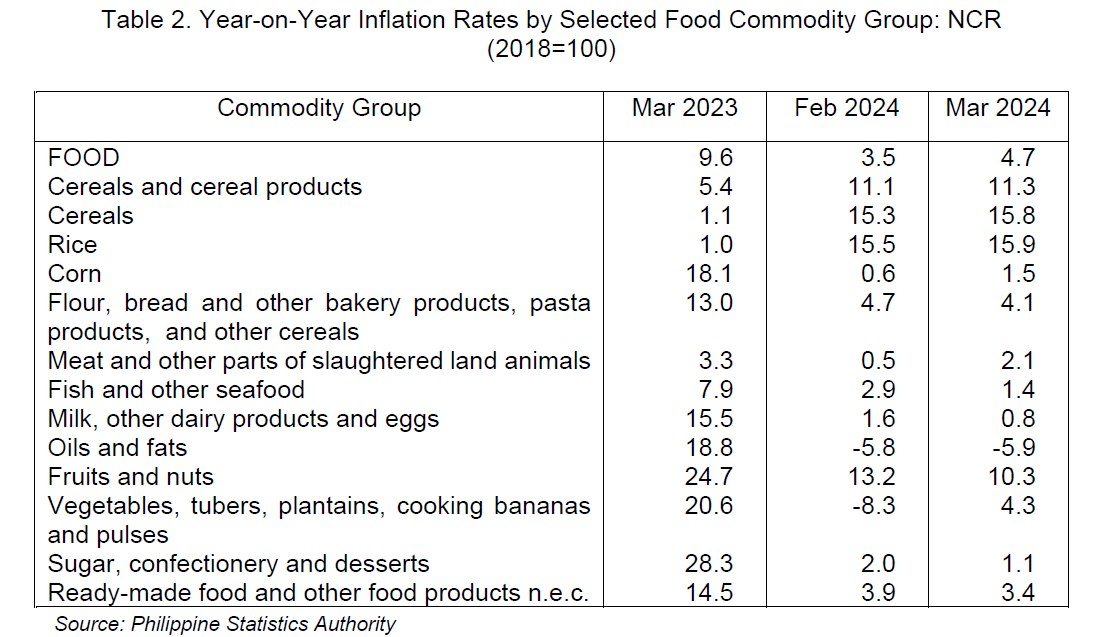
Purchasing Power of the Peso (PPP)
The PPP is a measure of the real value of the peso in a given period relative to a chosen reference period and is computed by getting the reciprocal of the CPI and multiplying the result by 100.
The PPP is inversely related to the CPI thus an increase in the CPI will result in a decrease in the PPP.
In March 2024, the PPP in NCR remains at 0.82, this is the third time that the PPP held on to its previous month’s level. The PPP in March 2023 was at 0.85. (Figure 3)
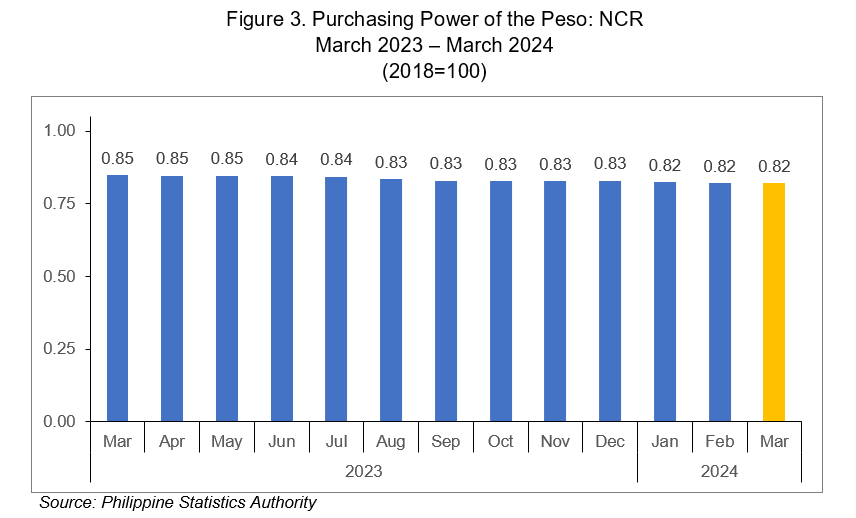
PACIANO B. DIZON
Regional Director
